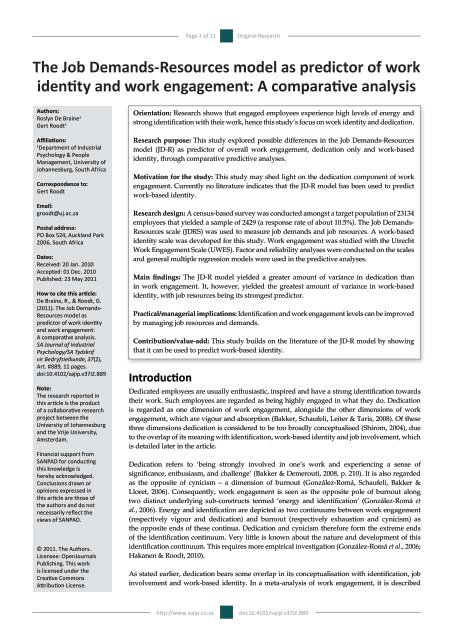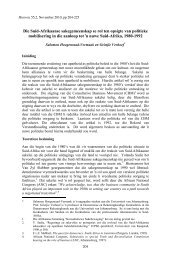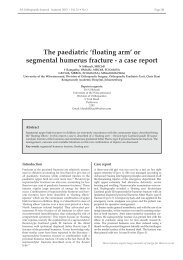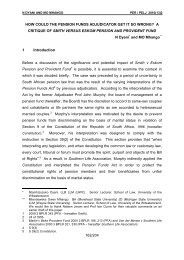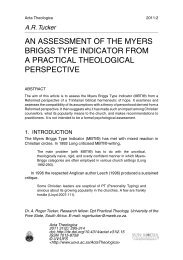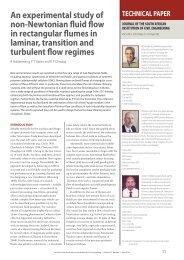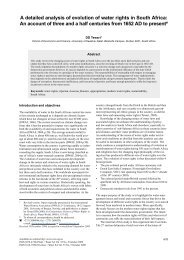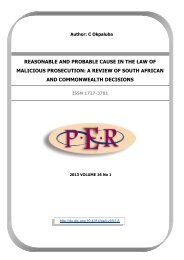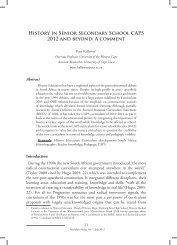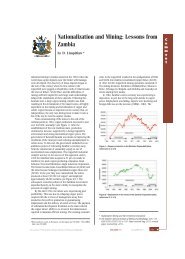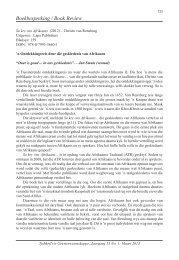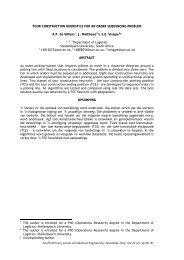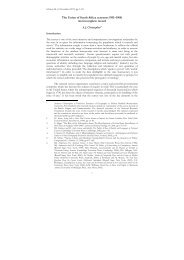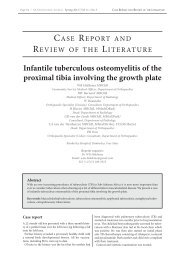The Job Demands-Resources model as predictor of work identity ...
The Job Demands-Resources model as predictor of work identity ...
The Job Demands-Resources model as predictor of work identity ...
You also want an ePaper? Increase the reach of your titles
YUMPU automatically turns print PDFs into web optimized ePapers that Google loves.
Page 1 <strong>of</strong> 11<br />
Original Research<br />
<strong>The</strong> <strong>Job</strong> <strong>Demands</strong>-<strong>Resources</strong> <strong>model</strong> <strong>as</strong> <strong>predictor</strong> <strong>of</strong> <strong>work</strong><br />
<strong>identity</strong> and <strong>work</strong> engagement: A comparative analysis<br />
Authors:<br />
Roslyn De Braine 1<br />
Gert Roodt 1<br />
Affiliations:<br />
1<br />
Department <strong>of</strong> Industrial<br />
Psychology & People<br />
Management, University <strong>of</strong><br />
Johannesburg, South Africa<br />
Correspondence to:<br />
Gert Roodt<br />
Email:<br />
groodt@uj.ac.za<br />
Postal address:<br />
PO Box 524, Auckland Park<br />
2006, South Africa<br />
Dates:<br />
Received: 20 Jan. 2010<br />
Accepted: 01 Dec. 2010<br />
Published: 23 May 2011<br />
How to cite this article:<br />
De Braine, R., & Roodt, G.<br />
(2011). <strong>The</strong> <strong>Job</strong> <strong>Demands</strong>-<br />
<strong>Resources</strong> <strong>model</strong> <strong>as</strong><br />
<strong>predictor</strong> <strong>of</strong> <strong>work</strong> <strong>identity</strong><br />
and <strong>work</strong> engagement:<br />
A comparative analysis.<br />
SA Journal <strong>of</strong> Industrial<br />
Psychology/SA Tydskrif<br />
vir Bedryfsielkunde, 37(2),<br />
Art. #889, 11 pages.<br />
doi:10.4102/sajip.v37i2.889<br />
Note:<br />
<strong>The</strong> research reported in<br />
this article is the product<br />
<strong>of</strong> a collaborative research<br />
project between the<br />
University <strong>of</strong> Johannesburg<br />
and the Vrije University,<br />
Amsterdam.<br />
Financial support from<br />
SANPAD for conducting<br />
this knowledge is<br />
hereby acknowledged.<br />
Conclusions drawn or<br />
opinions expressed in<br />
this article are those <strong>of</strong><br />
the authors and do not<br />
necessarily reflect the<br />
views <strong>of</strong> SANPAD.<br />
© 2011. <strong>The</strong> Authors.<br />
Licensee: OpenJournals<br />
Publishing. This <strong>work</strong><br />
is licensed under the<br />
Creative Commons<br />
Attribution License.<br />
Orientation: Research shows that engaged employees experience high levels <strong>of</strong> energy and<br />
strong identification with their <strong>work</strong>, hence this study’s focus on <strong>work</strong> <strong>identity</strong> and dedication.<br />
Research purpose: This study explored possible differences in the <strong>Job</strong> <strong>Demands</strong>-<strong>Resources</strong><br />
<strong>model</strong> (JD-R) <strong>as</strong> <strong>predictor</strong> <strong>of</strong> overall <strong>work</strong> engagement, dedication only and <strong>work</strong>-b<strong>as</strong>ed<br />
<strong>identity</strong>, through comparative predictive analyses.<br />
Motivation for the study: This study may shed light on the dedication component <strong>of</strong> <strong>work</strong><br />
engagement. Currently no literature indicates that the JD-R <strong>model</strong> h<strong>as</strong> been used to predict<br />
<strong>work</strong>-b<strong>as</strong>ed <strong>identity</strong>.<br />
Research design: A census-b<strong>as</strong>ed survey w<strong>as</strong> conducted amongst a target population <strong>of</strong> 23134<br />
employees that yielded a sample <strong>of</strong> 2429 (a response rate <strong>of</strong> about 10.5%). <strong>The</strong> <strong>Job</strong> <strong>Demands</strong>-<br />
<strong>Resources</strong> scale (JDRS) w<strong>as</strong> used to me<strong>as</strong>ure job demands and job resources. A <strong>work</strong>-b<strong>as</strong>ed<br />
<strong>identity</strong> scale w<strong>as</strong> developed for this study. Work engagement w<strong>as</strong> studied with the Utrecht<br />
Work Engagement Scale (UWES). Factor and reliability analyses were conducted on the scales<br />
and general multiple regression <strong>model</strong>s were used in the predictive analyses.<br />
Main findings: <strong>The</strong> JD-R <strong>model</strong> yielded a greater amount <strong>of</strong> variance in dedication than<br />
in <strong>work</strong> engagement. It, however, yielded the greatest amount <strong>of</strong> variance in <strong>work</strong>-b<strong>as</strong>ed<br />
<strong>identity</strong>, with job resources being its strongest <strong>predictor</strong>.<br />
Practical/managerial implications: Identification and <strong>work</strong> engagement levels can be improved<br />
by managing job resources and demands.<br />
Contribution/value-add: This study builds on the literature <strong>of</strong> the JD-R <strong>model</strong> by showing<br />
that it can be used to predict <strong>work</strong>-b<strong>as</strong>ed <strong>identity</strong>.<br />
Introduction<br />
Dedicated employees are usually enthusi<strong>as</strong>tic, inspired and have a strong identification towards<br />
their <strong>work</strong>. Such employees are regarded <strong>as</strong> being highly engaged in what they do. Dedication<br />
is regarded <strong>as</strong> one dimension <strong>of</strong> <strong>work</strong> engagement, alongside the other dimensions <strong>of</strong> <strong>work</strong><br />
engagement, which are vigour and absorption (Bakker, Schaufeli, Leiter & Taris, 2008). Of these<br />
three dimensions dedication is considered to be too broadly conceptualised (Shirom, 2004), due<br />
to the overlap <strong>of</strong> its meaning with identification, <strong>work</strong>-b<strong>as</strong>ed <strong>identity</strong> and job involvement, which<br />
is detailed later in the article.<br />
Dedication refers to ‘being strongly involved in one’s <strong>work</strong> and experiencing a sense <strong>of</strong><br />
significance, enthusi<strong>as</strong>m, and challenge’ (Bakker & Demerouti, 2008, p. 210). It is also regarded<br />
<strong>as</strong> the opposite <strong>of</strong> cynicism – a dimension <strong>of</strong> burnout (González-Romá, Schaufeli, Bakker &<br />
Lloret, 2006). Consequently, <strong>work</strong> engagement is seen <strong>as</strong> the opposite pole <strong>of</strong> burnout along<br />
two distinct underlying sub-constructs termed ‘energy and identification’ (González-Romá et<br />
al., 2006). Energy and identification are depicted <strong>as</strong> two continuums between <strong>work</strong> engagement<br />
(respectively vigour and dedication) and burnout (respectively exhaustion and cynicism) <strong>as</strong><br />
the opposite ends <strong>of</strong> these continua. Dedication and cynicism therefore form the extreme ends<br />
<strong>of</strong> the identification continuum. Very little is known about the nature and development <strong>of</strong> this<br />
identification continuum. This requires more empirical investigation (González-Romá et al., 2006;<br />
Hakanen & Roodt, 2010).<br />
As stated earlier, dedication bears some overlap in its conceptualisation with identification, job<br />
involvement and <strong>work</strong>-b<strong>as</strong>ed <strong>identity</strong>. In a meta-analysis <strong>of</strong> <strong>work</strong> engagement, it is described<br />
http://www.sajip.co.za<br />
doi:10.4102/sajip.v37i2.889
Page 2 <strong>of</strong> 11<br />
Original Research<br />
<strong>as</strong> ‘an identification-b<strong>as</strong>ed component <strong>of</strong> engagement’<br />
(Halbesleben, 2010, p.110). This relationship that <strong>work</strong><br />
engagement h<strong>as</strong> with identification stems from the early<br />
conceptualisations <strong>of</strong> engagement by Kahn (1990). Kahn<br />
(1990, p. 694) conceptualised engagement at <strong>work</strong> <strong>as</strong> ‘the<br />
harnessing <strong>of</strong> organisational members’ selves to their <strong>work</strong><br />
roles’. Kahn (1992) later argued that engaged employees<br />
experience psychological presence in their <strong>work</strong> that becomes<br />
integrated into their <strong>identity</strong>. This definition <strong>of</strong> engagement<br />
h<strong>as</strong> some resemblance to the definition <strong>of</strong> <strong>work</strong> <strong>identity</strong> by<br />
Walsh and Gordon (2007) that:<br />
an individual’s <strong>work</strong> <strong>identity</strong> refers to a <strong>work</strong>-b<strong>as</strong>ed self-concept,<br />
constituted <strong>of</strong> a combination <strong>of</strong> organisational, occupational,<br />
and other identities that shapes the roles a person adopts and<br />
the corresponding ways he or she behaves when performing his<br />
or her <strong>work</strong>.<br />
(Walsh & Gordon, 2007, p. 2)<br />
Although at first glance, the definition <strong>of</strong> <strong>work</strong> <strong>identity</strong><br />
may seem different from Kahn’s definition <strong>of</strong> engagement,<br />
a closer investigation shows that they share some similarity<br />
in that they both refer to different identities or ‘selves’ and<br />
<strong>work</strong> roles.<br />
<strong>The</strong> definition <strong>of</strong> <strong>work</strong> engagement by Bakker and Leiter<br />
(2010, p. 188) also provides a different understanding<br />
<strong>of</strong> dedication, <strong>as</strong> they include both involvement and<br />
identification in its definition. Work engagement is defined<br />
<strong>as</strong> ‘a subjective experience with two core dimensions: energy<br />
and involvement/identification’ (p. 188). In an earlier study,<br />
dedication h<strong>as</strong> been defined <strong>as</strong> ‘strong involvement that<br />
goes one step further than the usual level <strong>of</strong> identification’<br />
(Schaufeli, Salanova, González-Romá & Bakker, 2002, p. 74).<br />
This relationship <strong>of</strong> identification with job involvement<br />
stems from Lodahl and Kejner’s (1965, p. 24) definition <strong>of</strong> job<br />
involvement ‘<strong>as</strong> the degree to which a person is identified<br />
psychologically with his <strong>work</strong>, or the importance <strong>of</strong> <strong>work</strong> in<br />
his <strong>work</strong> self-image’ and Kanungo’s (1982) description <strong>of</strong> job<br />
involvement <strong>as</strong> psychological identification with one’s <strong>work</strong><br />
or one’s job. In both explanations <strong>of</strong> job involvement there<br />
is a degree <strong>of</strong> overlap with the definition <strong>of</strong> <strong>work</strong> <strong>identity</strong>,<br />
<strong>as</strong> discussed earlier, and Kahn’s definition <strong>of</strong> engagement.<br />
<strong>The</strong> preceding discussion necessitates the need to further<br />
empirically investigate identification (Hakanen & Roodt,<br />
2010). This will be conducted by comparing dedication, <strong>work</strong><br />
engagement and <strong>work</strong>-b<strong>as</strong>ed <strong>identity</strong> (identification with<br />
various facets <strong>of</strong> <strong>work</strong>) when using the same set <strong>of</strong> <strong>predictor</strong>s<br />
(resources and demands).<br />
This study then aims to make a contribution towards the<br />
understanding <strong>of</strong> identification, and thus perhaps gain<br />
more understanding on the dedication dimension <strong>of</strong> <strong>work</strong><br />
engagement. Because dedication is described <strong>as</strong> identification<br />
and involvement, the question may be <strong>as</strong>ked: Is <strong>work</strong>-b<strong>as</strong>ed<br />
<strong>identity</strong> distinct from dedication and distinct from <strong>work</strong><br />
engagement?<br />
B<strong>as</strong>ed on this, the following research objectives drive this<br />
study:<br />
• Compare overall <strong>work</strong> engagement, dedication only<br />
(subscale <strong>of</strong> <strong>work</strong> engagement) and <strong>work</strong>-b<strong>as</strong>ed <strong>identity</strong>.<br />
• To establish whether the JD-R <strong>model</strong> (Bakker &<br />
Demerouti, 2008) that h<strong>as</strong> been used to predict <strong>work</strong><br />
engagement, can predict <strong>work</strong>-b<strong>as</strong>ed <strong>identity</strong>. <strong>The</strong><br />
motivation behind using this <strong>model</strong> is b<strong>as</strong>ed on the<br />
postulation that <strong>work</strong>-b<strong>as</strong>ed <strong>identity</strong> is developed<br />
through a complex negotiation process between an<br />
individual’s personal resources and <strong>work</strong> characteristics<br />
(Kirpal, 2004b). Work characteristics can be divided into<br />
two broad categories: job demands and job resources, <strong>as</strong><br />
postulated in the JD-R <strong>model</strong> (Xanthopoulou, Bakker,<br />
Demerouti, & Schaufeli, 2007).<br />
<strong>The</strong>re have been numerous studies conducted on <strong>work</strong><br />
engagement in the South African context (Barkhuizen &<br />
Rothmann, 2008; Fourie, Rothmann & Van de Vijver, 2008;<br />
Mostert, Cronje & Pienaar, 2006), however, there is very<br />
little research done on <strong>work</strong>-b<strong>as</strong>ed <strong>identity</strong> in South Africa.<br />
Furthermore, <strong>work</strong>-b<strong>as</strong>ed <strong>identity</strong> h<strong>as</strong> also been regarded<br />
<strong>as</strong> a construct that h<strong>as</strong> ‘come <strong>of</strong> age in organisational<br />
literature’ due to the changing <strong>work</strong>place and its influence<br />
on employees (Agostino, 2004, p. 22). <strong>The</strong> available research<br />
on <strong>work</strong>-b<strong>as</strong>ed <strong>identity</strong> h<strong>as</strong> been solely focused on the <strong>work</strong><br />
identities <strong>of</strong> employees within first world contexts, namely<br />
the European context (e.g. the FAME Consortium in France,<br />
Germany and the UK, cited in Dif, 2004) and the American<br />
context (Buche, 2003). To date, there h<strong>as</strong> been very little<br />
research on the <strong>work</strong>-b<strong>as</strong>ed identities <strong>of</strong> individuals within<br />
the African context and specifically the South African context.<br />
In addition, very little research h<strong>as</strong> focused on <strong>work</strong>-b<strong>as</strong>ed<br />
<strong>identity</strong> and its prediction, except for one study in which<br />
role <strong>identity</strong> and job characteristics were used to predict IT<br />
pr<strong>of</strong>essionals’ <strong>work</strong> <strong>identity</strong> (Buche, 2003). <strong>The</strong>re is need to<br />
‘develop (and test) a series <strong>of</strong> related hypotheses’ on <strong>work</strong>b<strong>as</strong>ed<br />
<strong>identity</strong> (Walsh & Gordon, 2007, p. 13).<br />
Review <strong>of</strong> the literature<br />
Work engagement<br />
Work engagement is ‘a positive, fulfilling, affectivemotivational<br />
state <strong>of</strong> <strong>work</strong>-related wellbeing’ (Bakker et al.,<br />
2008, p. 188). It is defined and operationalised <strong>as</strong> ‘a positive,<br />
fulfilling <strong>work</strong>-related state <strong>of</strong> mind that is characterised<br />
by vigour, dedication and absorption’ (Schaufeli et al.,<br />
2002, p.74). Vigour is characterised by high levels <strong>of</strong> energy<br />
and mental resilience; dedication is experienced when<br />
individuals are enthusi<strong>as</strong>tic, inspired and challenged whilst<br />
doing their <strong>work</strong>; and absorption is characterised by being<br />
very engrossed in one’s <strong>work</strong> (Bakker et al., 2008, p. 188).<br />
Recent research reveals that the main dimensions <strong>of</strong> <strong>work</strong><br />
engagement are vigour and dedication (González-Romá<br />
et al., 2006). Employees that are engaged experience high<br />
levels <strong>of</strong> energy and strong identification towards their <strong>work</strong><br />
(Bakker et al., 2008; Bakker & Demerouti, 2008). <strong>The</strong>y are also<br />
better enabled to handle job demands (Schaufeli, Taris & Van<br />
Rhenen, 2009).<br />
Studies on <strong>work</strong> engagement using the JD-R <strong>model</strong> <strong>as</strong> a<br />
frame<strong>work</strong> have confirmed that <strong>work</strong> engagement is mainly<br />
http://www.sajip.co.za<br />
doi:10.4102/sajip.v37i2.889
Page 3 <strong>of</strong> 11<br />
Original Research<br />
predicted by job resources, particularly when job demands<br />
are high (Bakker, Hakanen, Demerouti, & Xanthopoulou,<br />
2007). <strong>The</strong>se findings are also supported by South African<br />
studies (Mostert, Cronje & Pienaar, 2006; Rothmann &<br />
Jordaan, 2006). Work engagement also mediates the effects<br />
<strong>of</strong> job resources on organisational commitment (Hakanen,<br />
Bakker & Schaufeli, 2006).<br />
Work-b<strong>as</strong>ed <strong>identity</strong><br />
<strong>The</strong> following descriptions may clarify the concept. Work<br />
<strong>identity</strong> h<strong>as</strong> been described <strong>as</strong> the way individuals define<br />
themselves at <strong>work</strong> (Wrzesniewski & Dutton, 2001). A further<br />
elaboration on the concept h<strong>as</strong> been provided by Witt, Patti<br />
and Farmer (2002, p. 488) who view <strong>work</strong> <strong>identity</strong> <strong>as</strong> a ‘<strong>work</strong>relevant<br />
target with which the individual primarily identifies:<br />
the occupation or the employing organisation’. Another<br />
description that is more inclusive <strong>of</strong> other components <strong>of</strong> the<br />
<strong>work</strong> environment is that:<br />
<strong>work</strong> identities are primarily identification with the <strong>work</strong><br />
environment, the company, the company’ s objectives or the<br />
<strong>work</strong>-related activities and t<strong>as</strong>ks which individuals perform that<br />
make individual and collective productivity possible.<br />
(Kirpal, 2004a, p. 274)<br />
Kirpal (2004b, p. 202) further elaborated on <strong>work</strong>-<strong>identity</strong><br />
that it is a multilayered and a multidimensional. Other<br />
descriptions focus more on the ‘self’. Buche (2003, p. 10) in<br />
her study <strong>of</strong> IT pr<strong>of</strong>essionals’ <strong>work</strong> identities describes it <strong>as</strong> ‘a<br />
socially constructed representation <strong>of</strong> an individual’s unique<br />
self-perception b<strong>as</strong>ed on his or her interactions within the<br />
employment environment’. Buche (2003, p. 4) further argues<br />
that <strong>work</strong> <strong>identity</strong> addresses ‘an employee’s self-image …<br />
who they see when they look in a mirror’.<br />
In this study the following theoretical definitions have been<br />
used. Walsh and Gordon (2007) define <strong>work</strong> <strong>identity</strong> <strong>as</strong>:<br />
a <strong>work</strong>-b<strong>as</strong>ed self-concept, constituted <strong>of</strong> a combination <strong>of</strong><br />
organisational, occupational, and other identities that shapes<br />
the roles a person adopts and the corresponding ways he or she<br />
behaves when performing his or her <strong>work</strong>.<br />
(Walsh & Gordon, 2007, p. 2)<br />
<strong>The</strong> other definition describes <strong>work</strong>-b<strong>as</strong>ed <strong>identity</strong> <strong>as</strong> ‘a<br />
multi-<strong>identity</strong>, multi-faceted and multi-layered construction<br />
<strong>of</strong> the self (in which the self-concept fulfils a core, integrative<br />
function), that shapes the roles individuals are involved in,<br />
within their employment context’ (Lloyd, Roodt & Odendaal,<br />
2011).<br />
Both <strong>of</strong> these aforementioned theoretical definitions <strong>of</strong> <strong>work</strong>b<strong>as</strong>ed<br />
<strong>identity</strong> are grounded in personal <strong>identity</strong>, social<br />
<strong>identity</strong> theory and <strong>identity</strong> theory. Both the definitions<br />
include the ‘self-concept’ <strong>as</strong> being multifaceted (Brewer &<br />
Gardner, 1996). Both definitions also make reference to the<br />
roles that individuals adopt and fulfil in their <strong>work</strong>. This<br />
is strongly supported by <strong>identity</strong> theory (Stets & Burke,<br />
2000). A third re<strong>as</strong>on for their inclusion in this study is<br />
that the <strong>work</strong>-b<strong>as</strong>ed self-concept consists <strong>of</strong> a combination<br />
<strong>of</strong> organisational, occupational and other identities. This is<br />
supported by social <strong>identity</strong> theory and social categorisation<br />
theory because individuals identify with categories or groups,<br />
such <strong>as</strong> an organisation, a <strong>work</strong> team or an occupational<br />
group (Ashforth & Mael, 1989).<br />
Considering these theoretical definitions, <strong>work</strong>-b<strong>as</strong>ed<br />
<strong>identity</strong>, due to its multifaceted and multi-<strong>identity</strong><br />
characteristic, is operationalised by an array <strong>of</strong> possible<br />
indicators which include <strong>work</strong> centrality, job involvement,<br />
organisational identification, person-organisation fit, job<br />
and career/occupational <strong>identity</strong> in this study. In order to<br />
understand the importance <strong>of</strong> each <strong>of</strong> the abovementioned<br />
indicators in <strong>work</strong>-b<strong>as</strong>ed <strong>identity</strong>, we will make use <strong>of</strong> Kirpal’s<br />
(2004a) perspective on the dimensions that influence <strong>identity</strong><br />
formation processes. <strong>The</strong> three dimensions are structural,<br />
social and the individual psychological dimension. <strong>The</strong>se<br />
three dimensions have been used to develop a <strong>work</strong>-b<strong>as</strong>ed<br />
<strong>identity</strong> prototype.<br />
<strong>The</strong> structural dimension refers to individual and societal<br />
paradigms <strong>of</strong> <strong>work</strong> that are influenced and shaped by how<br />
<strong>work</strong>, training systems and patterns <strong>of</strong> employment are<br />
embedded within a country’s current and historical culture<br />
(Kirpal, 2004a). South Africa’s transition from an apartheid<br />
regime to democracy h<strong>as</strong> changed the meaning <strong>of</strong> ‘South<br />
African’ (Distiller, 2008, p. 273). Through labour law reforms,<br />
the South African <strong>work</strong>place h<strong>as</strong> incre<strong>as</strong>ed in diversity<br />
and placed more emph<strong>as</strong>is on skill development for the<br />
previously disadvantaged race groups.<br />
<strong>The</strong> social dimension refers to the social interaction that<br />
individuals engage in with other individuals (i.e. colleagues<br />
and supervisors), groups (i.e. communities <strong>of</strong> practice, <strong>work</strong>units<br />
and occupational groups) and/or institutional bodies<br />
(i.e. trade unions and pr<strong>of</strong>essional bodies) (Kirpal, 2004a).<br />
<strong>The</strong> indicators <strong>of</strong> <strong>work</strong>-b<strong>as</strong>ed <strong>identity</strong> that fall under this<br />
social dimension include occupational or career <strong>identity</strong> and<br />
organisational identification.<br />
<strong>The</strong> individual-psychological dimension specifically focuses on<br />
the individual’s personal <strong>identity</strong> orientation. This dimension<br />
focuses on the career history and pr<strong>of</strong>essional development<br />
<strong>of</strong> individuals (Kirpal, 2004a) and it also focuses on how an<br />
individual perceives his or her <strong>work</strong> (Kirpal, 2004a). <strong>The</strong><br />
indicators <strong>of</strong> <strong>work</strong>-b<strong>as</strong>ed <strong>identity</strong> that fall under this social<br />
dimension include <strong>work</strong> centrality, job involvement and<br />
person-organisation fit.<br />
<strong>The</strong> literature on <strong>work</strong>-b<strong>as</strong>ed <strong>identity</strong> h<strong>as</strong> been limited in<br />
the sense that the focus h<strong>as</strong> been on building existing social<br />
<strong>identity</strong> theory by theoretically examining the development<br />
<strong>of</strong> <strong>work</strong> identities (Walsh & Gordon, 2007). <strong>The</strong>re h<strong>as</strong> also<br />
been a considerable amount <strong>of</strong> research conducted on how<br />
<strong>work</strong> identities have changed due to globalisation (Huws,<br />
2006), changing <strong>work</strong> systems (Baugher, 2003; Brown, 2004;<br />
Dif, 2004; FAME Consortium cited in Kirpal, 2004b) and<br />
‘employees’ responses to structural changes and new modes<br />
<strong>of</strong> socialization at <strong>work</strong>’ (Dif, 2004, p. 305).<br />
http://www.sajip.co.za<br />
doi:10.4102/sajip.v37i2.889
Page 4 <strong>of</strong> 11<br />
Original Research<br />
<strong>The</strong> <strong>Job</strong> <strong>Demands</strong>-<strong>Resources</strong> Model<br />
<strong>The</strong> JD-R <strong>model</strong> attributes employee wellbeing to the<br />
characteristics <strong>of</strong> the <strong>work</strong> environment (Xanthopoulou et<br />
al., 2007). Work characteristics can be divided into two broad<br />
categories:<br />
• job demands<br />
• job resources.<br />
<strong>The</strong> JD-R <strong>model</strong> is considered to be a better <strong>model</strong> to predict<br />
employee well-being, <strong>work</strong> engagement and burnout than<br />
older type <strong>of</strong> <strong>model</strong>s, <strong>as</strong> it can be used to <strong>as</strong>sess any type<br />
<strong>of</strong> job. <strong>The</strong> older <strong>model</strong>s that have been used included the<br />
<strong>Job</strong> <strong>Demands</strong> Control Model (Kar<strong>as</strong>ek, 1979) and the Effort<br />
Reward Imbalance Model (Siegrist, 1996). <strong>The</strong>se <strong>model</strong>s<br />
considered only a limited number <strong>of</strong> job characteristics<br />
(Bakker & Demerouti, 2007; Van den Broeck, Vansteenkiste,<br />
De Witte & Lens, 2008) in comparison to the JD-R <strong>model</strong><br />
that considers all types <strong>of</strong> job demands and job resources in<br />
predicting <strong>work</strong> engagement.<br />
Furthermore the JD-R <strong>model</strong>’s strength lies in its ability to<br />
understand two parallel processes that influence employee<br />
well-being. <strong>The</strong>se include (Hakanen, Bakker, & Schaufeli,<br />
2006):<br />
• a de-energising process in which job demands exhaust an<br />
employee’s mental and physical resources, which could<br />
lead to burnout and eventually ill health<br />
• a motivational process in which job resources promotes<br />
<strong>work</strong> engagement and could lead to organisational<br />
commitment.<br />
<strong>Job</strong> demands and its relationship with <strong>work</strong> engagement will<br />
be discussed in the following section.<br />
<strong>Job</strong> demands are defined <strong>as</strong> those physical, psychological,<br />
social or organisational <strong>as</strong>pects <strong>of</strong> a job that require<br />
sustained physical and/or psychological (cognitive and<br />
emotional) effort or skills and are therefore <strong>as</strong>sociated with<br />
certain physiological and/or psychological costs (Bakker &<br />
Demerouti, 2007, p. 312). As stated earlier, job demands are<br />
part <strong>of</strong> the de-energising process that underlines the JD-R<br />
<strong>model</strong>.<br />
<strong>The</strong> de-energising process is built on the premises <strong>of</strong><br />
Hockey’s (1997) Compensatory Regulatory-Control (CRC)<br />
<strong>model</strong> which states that stressed employees struggle with<br />
protecting their primary performance goals (benefits) in the<br />
midst <strong>of</strong> dealing with incre<strong>as</strong>ed job demands that require an<br />
incre<strong>as</strong>ed amount <strong>of</strong> mental effort (costs). An employee’s<br />
compensatory effort h<strong>as</strong> to be mobilised to deal with this<br />
struggle. If the compensatory effort is continuous, then the<br />
employee will experience energy loss which could possibly<br />
result in burnout and eventually ill-health. This process is<br />
<strong>as</strong>sociated with physiological and psychological costs, such<br />
<strong>as</strong> incre<strong>as</strong>ed sympathetic activity, fatigue and motivation<br />
loss (Hakanen et al., 2006, p. 498). This process is supported<br />
by a cross-lagged longitudinal study conducted on Finnish<br />
dentists in which job demands were positively correlated<br />
with burnout and depression over a period <strong>of</strong> three years<br />
(Hakanen, Schaufeli & Ahola, 2008).<br />
<strong>Job</strong> demands can further be grouped into quantitative and<br />
qualitative job demands. Quantitative job demands include<br />
time pressure and <strong>work</strong> overload. Qualitative demands<br />
include emotional demands, role ambiguity, role conflict and<br />
an unfavourable physical <strong>work</strong> environment.<br />
<strong>Job</strong> demands <strong>as</strong> part <strong>of</strong> the de-energising process have<br />
proven to be the strongest <strong>predictor</strong>s <strong>of</strong> the exhaustion<br />
and cynicism dimensions <strong>of</strong> burnout (Schaufeli & Bakker,<br />
2004; Xanthopoulou et al., 2007). This is supported by the<br />
proposition that employees who have high job demands<br />
with a lack <strong>of</strong> resources are likely to develop burnout and<br />
experience a reduction <strong>of</strong> engagement respectively (Hakanen,<br />
Bakker & Schaufeli, 2006). This can occur in all kinds <strong>of</strong> jobs<br />
and occupations (Bakker, Demerouti & Verbeke, 2004). A<br />
negative relationship w<strong>as</strong> found between <strong>work</strong> engagement<br />
and job demands; perceived job demands w<strong>as</strong> shown to<br />
predict burnout (Fourie, Rothmann & Van de Vijver, 2008).<br />
B<strong>as</strong>ed on the aforementioned discussion, the following<br />
research hypothesis is formulated:<br />
• Hypothesis 1: <strong>Job</strong> demands are negatively related to<br />
<strong>work</strong> engagement.<br />
Currently there is no literature indicating that job demands<br />
are correlated with <strong>work</strong>-b<strong>as</strong>ed <strong>identity</strong>. However, we can<br />
<strong>as</strong>sume that job demands are negatively correlated to <strong>work</strong>b<strong>as</strong>ed<br />
<strong>identity</strong> b<strong>as</strong>ed on the premises <strong>of</strong> Hockey’s (1997)<br />
CRC <strong>model</strong>, which w<strong>as</strong> discussed earlier. In support <strong>of</strong><br />
this, individuals who strongly identify with their <strong>work</strong> are<br />
highly engaged and display dedication, which is the opposite<br />
<strong>of</strong> cynicism – a dimension <strong>of</strong> burnout (González-Romá<br />
et al., 2006). If an employee’s compensatory effort h<strong>as</strong> to be<br />
continually mobilised to deal with high job demands, it is<br />
<strong>as</strong>sumed that identification will lessen and the employee will<br />
lean more towards experiencing cynicism. In light <strong>of</strong> this, the<br />
following hypothesis is formulated:<br />
• Hypothesis 2: <strong>Job</strong> demands are negatively related to<br />
<strong>work</strong>-b<strong>as</strong>ed <strong>identity</strong>.<br />
<strong>Job</strong> <strong>Resources</strong>, on the other hand, are those physical,<br />
psychological, social or organisational <strong>as</strong>pects <strong>of</strong> a job that<br />
either/or (Schaufeli & Bakker, 2004):<br />
• reduce job demands and the <strong>as</strong>sociated physiological and<br />
psychological costs<br />
• are functional in achieving <strong>work</strong> goals<br />
• stimulate personal growth, learning and development.<br />
As stated earlier, job resources are part <strong>of</strong> the motivational<br />
process that underlines the JD-R <strong>model</strong>.<br />
In the motivational process, job resources are known to<br />
influence employee well-being intrinsically through the<br />
fostering <strong>of</strong> employee growth, learning and development, or<br />
extrinsically by helping an employee to achieve his or her<br />
<strong>work</strong> goals (Hakanen et al., 2006). <strong>The</strong> self-determination<br />
theory provides support for this motivational process (Deci,<br />
Vallerand, Pelletier & Ryan, 1991). This theory postulates that<br />
if the need for competence, relatedness and autonomy (or<br />
http://www.sajip.co.za<br />
doi:10.4102/sajip.v37i2.889
Page 5 <strong>of</strong> 11<br />
Original Research<br />
self-determination) is met in any social context, well-being<br />
and incre<strong>as</strong>ed commitment is enhanced. Thus job resources<br />
play a vital role in promoting <strong>work</strong> engagement and finally<br />
organisational commitment.<br />
According to Bakker and Demerouti (2007) job resources<br />
are located at an organisational level (e.g. salary, career<br />
opportunities, access to resources and job security), at an<br />
interpersonal and social relations level (e.g. supervisor<br />
and co-<strong>work</strong>er support, and team climate), at the level <strong>of</strong><br />
organisation <strong>of</strong> <strong>work</strong> (e.g. role clarity and participation in<br />
decision making) and at the level <strong>of</strong> t<strong>as</strong>ks (e.g. skill variety,<br />
autonomy, performance feedback and t<strong>as</strong>k significance).<br />
<strong>Job</strong> resources have been found to be the strongest <strong>predictor</strong>s<br />
<strong>of</strong> <strong>work</strong> engagement (Bakker et al., 2008; Mauno, Kinnunen<br />
& Ruokolainen, 2007; Rothmann & Jordaan, 2006; Schaufeli<br />
& Bakker, 2004), especially in the presence <strong>of</strong> high job<br />
demands (Bakker et al., 2008; Rothmann & Jordaan, 2006).<br />
Furthermore, empirical evidence indicates that job resources<br />
are able to buffer the negative impact <strong>of</strong> job demands on<br />
burnout. Although the buffer effect <strong>of</strong> job resources will not<br />
be addressed <strong>as</strong> an objective in this study <strong>of</strong> <strong>work</strong>-b<strong>as</strong>ed<br />
<strong>identity</strong>, it h<strong>as</strong> been mentioned, to motivate how important<br />
job resources are in achieving employee well-being.<br />
<strong>Job</strong> resources are also considered to be crucial for employee<br />
retention. De Lange, De Witte and Notelaers (2008) found<br />
that low <strong>work</strong> engagement, low job autonomy and low<br />
departmental resources predicted employees’ leaving their<br />
companies and transferring to other companies.<br />
B<strong>as</strong>ed on the aforementioned discussion, the following<br />
research hypothesis is formulated:<br />
TABLE 1: Biographical and demographical details <strong>of</strong> the participants (n = 2429).<br />
Variable Category %<br />
Gender Female 36.8<br />
Male 63.2<br />
Race Black 26.3<br />
White 44.1<br />
Coloured 16.3<br />
Asian/ Indian 13.3<br />
Age 19−29 12.0<br />
30−39 39.5<br />
40−49 36.1<br />
50+ 12.4<br />
Level Management 18.4<br />
Operational 54.9<br />
Specialist 26.7<br />
Region Central 4.90<br />
Corporate 24.9<br />
E<strong>as</strong>tern 13.1<br />
Gauteng Central 18.5<br />
North E<strong>as</strong>tern 13.8<br />
Southern 6.50<br />
Western 18.2<br />
Qualifications Matric or less 40.7<br />
Post-school qualifications 19.7<br />
National Diploma/National Higher Diploma 26.9<br />
Bachelors Degree or equivalent, or more 12.7<br />
• Hypothesis 3: <strong>Job</strong> resources are positively related to<br />
<strong>work</strong> engagement.<br />
An employee-employer relationship is usually governed by<br />
a formal contract agreement and a psychological contract<br />
agreement. <strong>The</strong>se contracts occur within a relationship<br />
<strong>of</strong> exchange between the employee and employer. Social<br />
exchange theory aims to draw the link between the role <strong>of</strong><br />
job resources and this relationship <strong>of</strong> exchange between the<br />
employee and employer. <strong>The</strong> social exchange perspective<br />
is b<strong>as</strong>ed on the premise that the relationship between an<br />
employee and an organisation is built on a transaction <strong>of</strong><br />
effort and commitment for the benefits <strong>of</strong> receiving a salary,<br />
recognition and organisational support (Blau, 1964; Van<br />
Knippenberg, Van Dick & Tavares, 2007). A social exchange is<br />
judged to be one <strong>of</strong> quality when employee inputs (e.g. <strong>work</strong>,<br />
time and effort) into the relationship is on par or equivalent<br />
to the benefits (e.g. salary, promotion and recognition) that<br />
the employee receives from the relationship. Individuals<br />
then become more motivated to maintain the relationship<br />
(Van Knippenberg et al., 2007) and ‘the boundaries between<br />
the self and other’ is blurred and deep structure identification<br />
is able to develop (Rousseau, 1998, p. 222). Deep structure<br />
identification is a form <strong>of</strong> identification in which ‘cognitive<br />
schema formed in <strong>work</strong> settings across roles, over time, and<br />
across situations that leads to congruence between self-at<br />
<strong>work</strong> and one’s broader self concept’ (Turner, 1978 cited in<br />
Rousseau, 1998, p. 218).<br />
B<strong>as</strong>ed on the aforementioned discussion, the following<br />
research hypothesis is formulated:<br />
• Hypothesis 4: <strong>Job</strong> resources are positively related to<br />
<strong>work</strong>-b<strong>as</strong>ed <strong>identity</strong>.<br />
Research design<br />
Research approach<br />
<strong>The</strong> study follows the quantitative research tradition. A<br />
cross-sectional field survey w<strong>as</strong> used to generate the primary<br />
data in this study. Correlational data analysis techniques<br />
were applied in conducting the data analysis in order to<br />
explain relationships between variables on a retrospective<br />
b<strong>as</strong>is which typifies this research <strong>as</strong> ex post facto research.<br />
Research method<br />
<strong>The</strong> research method will be discussed under the following<br />
four sub-headings.<br />
Research participants and sampling<br />
A census-b<strong>as</strong>ed survey 1 w<strong>as</strong> conducted on the population <strong>of</strong><br />
employees (N = 23 134) who were in the employment <strong>of</strong> an<br />
Information and Communications Technology (ICT) sector<br />
company in South Africa. A response rate <strong>of</strong> 10.5% yielded<br />
a sample <strong>of</strong> 2429 research participants. <strong>The</strong> biographic and<br />
demographic characteristics <strong>of</strong> the sample are provided in<br />
Table 1.<br />
It h<strong>as</strong> been indicated that most respondents are White,<br />
Afrikaans or English speaking, male, married or cohabitating,<br />
1.A type <strong>of</strong> survey where everyone in the target population h<strong>as</strong> an equa chance to<br />
participate in the survey.<br />
http://www.sajip.co.za<br />
doi:10.4102/sajip.v37i2.889
Page 6 <strong>of</strong> 11<br />
Original Research<br />
in possession <strong>of</strong> academic qualifications higher than matric<br />
(grade 12), and <strong>work</strong>ing in either operational or specialist<br />
vocational applications (see Table 1).<br />
Me<strong>as</strong>uring instruments<br />
Demographic particulars <strong>of</strong> the participants were captured<br />
in the company’s IT system used for conducting the survey.<br />
<strong>The</strong> job demands and job resources were me<strong>as</strong>ured with several<br />
instruments. Most <strong>of</strong> the job demands and job resources<br />
were me<strong>as</strong>ured with the 42-item <strong>Job</strong> <strong>Demands</strong>-<strong>Resources</strong><br />
Scale (JDRS) that w<strong>as</strong> developed by Rothmann, Mostert and<br />
Strydom (2006). <strong>The</strong> following job demands (overall internal<br />
consistency w<strong>as</strong> 0.81) were included in the instrument with<br />
accompanying internal consistency reliabilities.<br />
<strong>Job</strong> insecurity w<strong>as</strong> me<strong>as</strong>ured with 3 items that were adapted<br />
from the JDRS; examples <strong>of</strong> the job insecurity items include<br />
‘How secure are you that you will still be <strong>work</strong>ing in one<br />
year’s time?’ and ‘How secure are you that you will keep<br />
your current job in the next year?’. <strong>The</strong> internal consistency<br />
reported for the scale in this study is 0.90.<br />
Overload w<strong>as</strong> me<strong>as</strong>ured with 8 items that were adapted from<br />
the JDRS; examples <strong>of</strong> the overload items include ‘How <strong>of</strong>ten<br />
do you have too much <strong>work</strong> to do?’ and ‘How frequently<br />
do you <strong>work</strong> under pressure?’. <strong>The</strong> internal consistency<br />
reported for the scale in this study is 0.78.<br />
Work-family conflict w<strong>as</strong> me<strong>as</strong>ured with a <strong>work</strong>-family<br />
conflict scale that w<strong>as</strong> adapted from Netemeyer, Boles and<br />
McMurriam (1996); examples <strong>of</strong> the <strong>work</strong>-family conflict<br />
items include ‘How much do the demands <strong>of</strong> your <strong>work</strong><br />
interfere with your home and family life?’ and ‘How <strong>of</strong>ten<br />
does your job put so much strain on you that you find it<br />
difficult to fulfil family duties?’. <strong>The</strong> internal consistency<br />
reported for the scale in this study is 0.96.<br />
<strong>The</strong> following job resources (overall internal consistency w<strong>as</strong><br />
0.94) were included in the study:<br />
• advancement<br />
• growth opportunities<br />
• organisational support<br />
• perceived external prestige<br />
• t<strong>as</strong>k <strong>identity</strong><br />
• team climate<br />
• <strong>work</strong>-b<strong>as</strong>ed <strong>identity</strong>.<br />
Advancement w<strong>as</strong> me<strong>as</strong>ured with 6 items that were adapted<br />
from the JDRS; examples <strong>of</strong> the advancement items include<br />
‘How good do you think your organisation’s salaries are?’<br />
and ‘To what extent does your job <strong>of</strong>fer you the possibility<br />
to progress financially?’. <strong>The</strong> internal consistency reported in<br />
this study is 0.83.<br />
Growth opportunities were me<strong>as</strong>ured with 7 items that were<br />
adapted from the JDRS; examples <strong>of</strong> the growth opportunities<br />
items are include ‘How much variety do you have in your<br />
<strong>work</strong>?’ and ‘And how much direct influence do you have<br />
on the decisions made by your organisation?’. <strong>The</strong> internal<br />
consistency reported for the scale in this study is 0.84.<br />
Organisational support w<strong>as</strong> me<strong>as</strong>ured with 18 items that<br />
were adapted from the JDRS; examples <strong>of</strong> organisational<br />
support items are include ‘How much can you count on your<br />
colleagues when you come across difficulties in your <strong>work</strong>?’<br />
and ‘How <strong>of</strong>ten if necessary, can you <strong>as</strong>k your colleagues for<br />
help?’. <strong>The</strong> internal consistency reported for this scale in this<br />
study is 0.91.<br />
Perceived external prestige w<strong>as</strong> me<strong>as</strong>ured with 5 items that were<br />
adapted from Riordan, Gatewood and Bill (1997); examples<br />
<strong>of</strong> perceived external prestige items are include ‘Generally,<br />
how good is (Company X’s) reputation in the community?’<br />
and ‘Generally, how good is (Company X’s) reputation in the<br />
industry?’. <strong>The</strong> Cronbach alpha reported is 0.90.<br />
T<strong>as</strong>k <strong>identity</strong> w<strong>as</strong> me<strong>as</strong>ured with 2 items that were adapted<br />
from Hackman and Oldham (1975). <strong>The</strong> two items are<br />
include ‘To what extent is your job arranged so that you have<br />
the chance to do an entire piece <strong>of</strong> <strong>work</strong> from beginning to<br />
end?’ and ‘How <strong>of</strong>ten does the job provide you the chance<br />
to completely finish the pieces <strong>of</strong> <strong>work</strong> you begin?’. <strong>The</strong><br />
Cronbach alpha reported for this scale in this study is 0.89.<br />
Team climate w<strong>as</strong> me<strong>as</strong>ured with 6 items that were adapted<br />
from Klivimaki and Elovaino (1999); examples <strong>of</strong> the team<br />
climate items include ‘How free do you feel to share ide<strong>as</strong><br />
for improvement in your division?’ and ‘How effectively<br />
organized is your division to support quality service?’. <strong>The</strong><br />
internal consistency reported for this scale in this study is<br />
0.89.<br />
Work-b<strong>as</strong>ed <strong>identity</strong> w<strong>as</strong> me<strong>as</strong>ured with a number <strong>of</strong> scales<br />
that me<strong>as</strong>ured its facets or indicators, which include:<br />
• <strong>work</strong> centrality<br />
• person–organisation-fit<br />
• organisational identification<br />
• job<br />
• career<br />
• occupation<br />
• <strong>work</strong>.<br />
Work-b<strong>as</strong>ed <strong>identity</strong> w<strong>as</strong> operationalised this way, <strong>as</strong> there<br />
were no suitable me<strong>as</strong>urements found that complied with<br />
the requirements <strong>of</strong> the theoretical definition <strong>of</strong> <strong>work</strong>-b<strong>as</strong>ed<br />
<strong>identity</strong>. A 7-point intensity response scale w<strong>as</strong> developed<br />
which w<strong>as</strong> anchored at extreme poles.<br />
<strong>The</strong> <strong>work</strong>-b<strong>as</strong>ed <strong>identity</strong> scale initially consisted <strong>of</strong> 36 items<br />
compiled <strong>as</strong> follows.<br />
Nineteen items were selected from a scale <strong>of</strong> Roodt (1997)<br />
that loaded on the sub scales labelled ‘<strong>work</strong>aholism’,<br />
‘organisational-related involvement or commitment’ and<br />
‘<strong>work</strong>-related alienation’.<br />
Workaholism showed a strong orientation towards the value<br />
<strong>of</strong> <strong>work</strong> or <strong>work</strong> centrality. <strong>The</strong> scale consists <strong>of</strong> 11 items<br />
http://www.sajip.co.za<br />
doi:10.4102/sajip.v37i2.889
Page 7 <strong>of</strong> 11<br />
Original Research<br />
and include examples such <strong>as</strong> ‘To what extent do you regard<br />
<strong>work</strong> <strong>as</strong> the most important <strong>as</strong>pect in your life?’ and ‘How<br />
much meaning does <strong>work</strong> add to your life?’.<br />
Five items were selected from organisational-related<br />
involvement/commitment, including ‘How much do you see<br />
your job <strong>as</strong> your whole life?’ and ‘How much do you give to<br />
your job?’.<br />
Three items were selected from <strong>work</strong>-related alienation;<br />
examples <strong>of</strong> the selected items include ‘How much does your<br />
<strong>work</strong> determine your value <strong>as</strong> a person?’ and ‘To what extent<br />
does your job allow for the achievement <strong>of</strong> personal goals?’.<br />
One item w<strong>as</strong> selected from the Lodahl and Kejner (1965) <strong>Job</strong><br />
Involvement Scale namely ‘How likely are you to regard your<br />
<strong>work</strong> <strong>as</strong> only a small part <strong>of</strong> who you are?’.<br />
Five items were selected from three subscales from <strong>The</strong><br />
Functions <strong>of</strong> Identity Scale <strong>of</strong> Serafini, Maitland and Adams<br />
(2006), namely:<br />
• structure (‘the structure <strong>of</strong> understanding <strong>of</strong> who one is’)<br />
• goals (‘meaning and direction through commitments,<br />
values and goals’)<br />
• future (‘to what extent do you feel that your <strong>work</strong> values<br />
and beliefs reflect who you are?’).<br />
<strong>The</strong> resulting Cronbach’s alpha w<strong>as</strong> 0.82. Items selected from<br />
this subscale were eventually dropped from the questionnaire<br />
after factor analysis (see Results section).<br />
Organisational identification w<strong>as</strong> <strong>as</strong>sessed with the 6-item scale<br />
from Mael and Ashforth (1992). Some <strong>of</strong> the adapted items<br />
included ‘How <strong>of</strong>ten do you say “we” rather than “they”<br />
when you talk about the organisation that you <strong>work</strong> for?’<br />
and ‘How interested are you in what others think about the<br />
organisation that you <strong>work</strong> for?’. A Cronbach Alpha <strong>of</strong> 0.88<br />
w<strong>as</strong> reported in this study.<br />
Person–Organisation-fit w<strong>as</strong> me<strong>as</strong>ured with 3 items from the<br />
Person–Organisation-fit Scale <strong>of</strong> Lauver and Krist<strong>of</strong>-Brown<br />
(2001); examples <strong>of</strong> the selected items include ‘To what degree<br />
do your values match or fit the values <strong>of</strong> the organisation<br />
that you <strong>work</strong> for?’ and ‘To what degree are you able to<br />
maintain your values at the organisation that you <strong>work</strong> for?’.<br />
A Cronbach alpha <strong>of</strong> 0.81 w<strong>as</strong> reported for this scale.<br />
All the items <strong>of</strong> the <strong>work</strong>-b<strong>as</strong>ed <strong>identity</strong> scale were me<strong>as</strong>ured<br />
on a 7-point intensity response scale anchored at extreme<br />
poles (e.g. ‘Highly unlikely’ 1 – low intensity to ‘Highly<br />
likely’ 7 – high intensity). Participants were <strong>as</strong>ked to use<br />
the me<strong>as</strong>uring scale to indicate the degree to which their<br />
answers accurately describe their own situation and feelings<br />
by clicking on the appropriate radio buttons.<br />
Reliability and validity <strong>of</strong> the instrument<br />
<strong>The</strong> 36-item questionnaire w<strong>as</strong> factor analysed on a first and<br />
second level to determine the factor structure. This resulted<br />
in the creation <strong>of</strong> the 28-item, uni-dimensional Work-b<strong>as</strong>ed<br />
Identity scale (Roodt, De Braine, Bothma & Jansen, 2009).<br />
Work engagement<br />
<strong>The</strong> Utrecht Work Engagement Scale (UWES) w<strong>as</strong> used to<br />
me<strong>as</strong>ure <strong>work</strong> engagement. <strong>The</strong> 17-item scale is composed<br />
<strong>of</strong> three subscales namely vigour (six items) with Cronbach<br />
alph<strong>as</strong> ranging from 0.75 to 0.82 (Schaufeli & Bakker, 2004),<br />
dedication (five items) with Cronbach alph<strong>as</strong> ranging from 0.88<br />
to 0.90 (Schaufeli & Bakker, 2004) and absorption (six items)<br />
with Cronbach alph<strong>as</strong> ranging from 0.70 to 0.75 (Schaufeli &<br />
Bakker, 2004); examples <strong>of</strong> the items include:<br />
• ‘At my <strong>work</strong>, I feel bursting with energy’ (vigor)<br />
• ‘I am enthusi<strong>as</strong>tic about my job’ (dedication)<br />
• ‘When I am <strong>work</strong>ing, I forget everything else around me’<br />
(absorption).<br />
<strong>The</strong> internal consistency reported for vigour w<strong>as</strong> 0.85, for<br />
dedication 0.91 and for absorption 0.85.<br />
All the items <strong>of</strong> the survey, except for the UWES scale, were<br />
me<strong>as</strong>ured on a 7-point intensity response scale anchored<br />
at extreme poles (e.g. ‘Highly unlikely’ 1 – low intensity to<br />
‘Highly likely’ 7 – high intensity).<br />
Research procedure<br />
An e-invitation letter w<strong>as</strong> sent out to all permanent employees,<br />
up to middle management <strong>of</strong> the ICT sector company. <strong>The</strong><br />
invitation included a web-link for access to the survey. <strong>The</strong><br />
survey w<strong>as</strong> constructed in such a manner that participants<br />
could complete individual sections <strong>of</strong> the survey, one section<br />
at a time, before submitting their final response.<br />
Statistical analysis<br />
<strong>The</strong> SPSS programme w<strong>as</strong> used to conduct the statistical<br />
analysis (Pallant, 2005). <strong>The</strong> following statistical techniques<br />
were used:<br />
• factor and reliability analyses<br />
• Pearson correlations<br />
• general multiple regression <strong>model</strong>s.<br />
<strong>The</strong> multiple regression <strong>model</strong>s included individual job<br />
resources and job demands variables for predicting both<br />
<strong>work</strong>-b<strong>as</strong>ed <strong>identity</strong> and <strong>work</strong> engagement.<br />
Results<br />
Factor and reliability analyses<br />
All the scales were subjected to a factor and reliability<br />
analysis. Item scores were inter-correlated and these matrices<br />
were subjected to the Kaiser-Meyer-Olkin and Bartlett’s tests<br />
for suitability for factor analyses. Single factor structures<br />
were obtained for all scales and acceptable reliabilities were<br />
obtained for all subscales and for the overall scales.<br />
<strong>The</strong> KMO-MSA values for the <strong>work</strong>-b<strong>as</strong>ed <strong>identity</strong>, <strong>work</strong><br />
engagement, job demands and job resources exceeded the<br />
recommended value <strong>of</strong> 0.60 (Tabachnick & Fidell, 2007). This<br />
indicated that the scales were suitable for factor analysis<br />
(Hair, Anderson, Tatham & Black, 1998).<br />
http://www.sajip.co.za<br />
doi:10.4102/sajip.v37i2.889
Page 8 <strong>of</strong> 11<br />
Original Research<br />
Work-b<strong>as</strong>ed <strong>identity</strong>, <strong>work</strong> engagement, job demands and<br />
job resources scales each underwent first and second level<br />
factor analysis. <strong>The</strong> principal axis factoring method w<strong>as</strong><br />
used. This w<strong>as</strong> then followed by an Oblimin rotation and by<br />
a scree test. All scales and subscales yielded a single factor<br />
structure where all items loaded onto the particular scale.<br />
Additional second-level factor analyses were conducted on<br />
the subscales <strong>of</strong> <strong>work</strong> engagement, job demands and job<br />
resources. <strong>The</strong> same procedure w<strong>as</strong> repeated for the secondlevel<br />
factor analyses, but in this c<strong>as</strong>e only the total scores <strong>of</strong><br />
the subscales were intercorrelated. For the <strong>work</strong> engagement<br />
scale a single factor w<strong>as</strong> extracted and it yielded an overall<br />
Cronbach Alpha <strong>of</strong> 0.91.<br />
Two factors were extracted from the <strong>work</strong>-b<strong>as</strong>ed <strong>identity</strong><br />
scale. <strong>The</strong> second factor (called future) w<strong>as</strong> omitted from<br />
further analyses <strong>as</strong> this factor w<strong>as</strong> nondetermined. Only 28<br />
items <strong>of</strong> the first factor (called <strong>work</strong>-b<strong>as</strong>ed <strong>identity</strong>) were<br />
retained and it yielded a Cronbach Alpha <strong>of</strong> 0.95 (Roodt, De<br />
Braine, Bothma & Jansen, 2009).<br />
<strong>The</strong> reliability coefficients for the scales’ <strong>work</strong>-b<strong>as</strong>ed <strong>identity</strong>,<br />
<strong>work</strong> engagement, job demands and job resources were all<br />
above the acceptable level <strong>of</strong> 0.70 (see Table 2), indicating<br />
that they me<strong>as</strong>ured single one-dimensional latent constructs.<br />
All the scales were treated <strong>as</strong> one-dimensional scales.<br />
<strong>The</strong> scales and subscales’ reliabilities and intercorrelations<br />
between the overall scales on the different scales are reported<br />
in Table 2.<br />
It is clear from Table 2 that all the scales have acceptable<br />
reliabilities. <strong>Job</strong> resources demonstrate much higher<br />
correlations with <strong>work</strong>-b<strong>as</strong>ed <strong>identity</strong>, <strong>work</strong> engagement<br />
and its subscales than job demands.<br />
Work engagement and <strong>work</strong>-b<strong>as</strong>ed <strong>identity</strong> were found<br />
to be positively and significantly related to one another,<br />
thereby indicating that these two constructs share about 50%<br />
common variance.<br />
Multiple regression analyses<br />
<strong>The</strong> next analysis took the form <strong>of</strong> multiple regression<br />
analyses in which job demands and job resources served<br />
<strong>as</strong> <strong>predictor</strong>s <strong>of</strong> <strong>work</strong> engagement (<strong>as</strong> me<strong>as</strong>ured by the<br />
UWES), <strong>of</strong> dedication (a dimension <strong>of</strong> <strong>work</strong> engagement<br />
also me<strong>as</strong>ured by the UWES); and <strong>of</strong> <strong>work</strong>-b<strong>as</strong>ed <strong>identity</strong> (<strong>as</strong><br />
me<strong>as</strong>ured by various scales) respectively.<br />
<strong>The</strong> results <strong>of</strong> the multiple regression analysis with job<br />
demands and job resources <strong>as</strong> independent variables and<br />
<strong>work</strong>-engagement <strong>as</strong> dependent variable is reported in<br />
Table 3.<br />
Results <strong>of</strong> regression analysis in predicting <strong>work</strong>engagement<br />
by job demands and job resources<br />
<strong>The</strong> results for job demands and job resources were similar<br />
when using two random split samples for <strong>work</strong> engagement.<br />
<strong>The</strong> results <strong>of</strong> the multiple regression analysis with job<br />
demands and job resources <strong>as</strong> independent variables and<br />
dedication (a subscale <strong>of</strong> <strong>work</strong>-engagement) <strong>as</strong> dependent<br />
variable is reported in Table 4.<br />
Results <strong>of</strong> regression analysis in predicting the dedication<br />
subscale <strong>of</strong> <strong>work</strong> engagement by job demands and job<br />
resources<br />
<strong>The</strong> results for job demands and job resources were similar<br />
when using one random sample for dedication. <strong>The</strong> results<br />
<strong>of</strong> the multiple regression analysis with job demands and job<br />
resources <strong>as</strong> independent variables and <strong>work</strong>-b<strong>as</strong>ed <strong>identity</strong><br />
<strong>as</strong> dependent variable is reported in Table 5.<br />
Results <strong>of</strong> regression analysis in predicting <strong>work</strong>-b<strong>as</strong>ed<br />
<strong>identity</strong> by job demands and job resources<br />
<strong>The</strong> results for job demands and job resources were similar<br />
when using two random split samples to the full sample for<br />
<strong>work</strong>-b<strong>as</strong>ed <strong>identity</strong>.<br />
Discussion<br />
<strong>The</strong> study aimed to make a contribution towards the<br />
understanding <strong>of</strong> identification, and thus perhaps gain<br />
more understanding on the dedication dimension <strong>of</strong> <strong>work</strong><br />
engagement. A further aim <strong>of</strong> this study is to establish<br />
whether the JD-R <strong>model</strong> that h<strong>as</strong> been used to predict<br />
<strong>work</strong> engagement, can predict <strong>work</strong>-b<strong>as</strong>ed <strong>identity</strong>. <strong>The</strong><br />
study makes an important contribution by comparing both<br />
<strong>work</strong>-b<strong>as</strong>ed <strong>identity</strong> and <strong>work</strong> engagement <strong>as</strong> a criterion.<br />
<strong>The</strong> results <strong>of</strong> the study make an important theoretical<br />
contribution in this respect <strong>as</strong> no results were reported in<br />
previous studies.<br />
TABLE 2: Mean, Standard Deviations, Internal Consistencies (Cronbach α’s on the Diagonal), and Correlations amongst the Variables (N = 2429).<br />
Variables M SD 1 2 3 4 5 6 7<br />
1. <strong>Job</strong> <strong>Demands</strong> 4.01 0.80 0.81 - - - - - -<br />
2. <strong>Job</strong> <strong>Resources</strong> 4.47 0.90 0.125** 0.94 - - - - -<br />
3. Work Engagement 4.50 1.23 0.160** 0.549** 0.95 - - - -<br />
4. Vigor 4.58 1.22 0.102** 0.524** - 0.85 - - -<br />
5. Dedication 4.44 1.47 0.139** 0.583** 0.583** 0.858** 0.91 - -<br />
6. Absorption 4.47 1.04 0.205** 0.440** - 0.794** 0.795** 0.85 -<br />
7. Work-b<strong>as</strong>ed <strong>identity</strong> 4.89 1.04 0.170** 0.617** 0.706** 0.656** 0.702** 0.627** 0.95<br />
M, Mean; SD, Standard Deviation.<br />
**, p < 0.01<br />
http://www.sajip.co.za<br />
doi:10.4102/sajip.v37i2.889
Page 9 <strong>of</strong> 11<br />
Original Research<br />
TABLE 3: Results <strong>of</strong> regression analysis in predicting <strong>work</strong>-engagement by job<br />
demands and job resources.<br />
Variable B SEB β p<br />
Constant 0.638 0.140 - 0.000<br />
<strong>Job</strong> demands 0.142 0.026 0.093 0.000<br />
<strong>Job</strong> resources 0.737 0.023 0.538 0.000<br />
R = 0.557ª - - - -<br />
R²= 0.310 - - - -<br />
∆R² = 0.310 - - - -<br />
B, Unstandardised coefficient and constant for the linear regression equation; SEB, Standard<br />
Error <strong>of</strong> B; β, <strong>The</strong> standardised regression coefficient; p, probability value.<br />
N = 2429.<br />
TABLE 4: Results <strong>of</strong> regression analysis in predicting the dedication sub-scale <strong>of</strong><br />
<strong>work</strong>-engagement by job demands and job resources.<br />
Variable B SEB β p<br />
Constant -0.227 0.162 - 0.161<br />
<strong>Job</strong> demands 0.122 0.030 0.067 0.000<br />
<strong>Job</strong> resources 0.935 0.027 0.575 0.000<br />
R = 0.587ª - - - -<br />
R²= 0.345 - - - -<br />
∆R² = 0.344 - - - -<br />
B, Unstandardised coefficient and constant for the linear regression equation; SEB, Standard<br />
Error <strong>of</strong> B; β, <strong>The</strong> standardised regression coefficient; p, probability value.<br />
N = 2429.<br />
TABLE 5: Results <strong>of</strong> regression analysis in predicting <strong>work</strong>-b<strong>as</strong>ed <strong>identity</strong> by<br />
job demands and job resources <strong>work</strong>-engagement by job demands and job<br />
resources.<br />
Variable B SEB β p<br />
Constant 1.263 0.111 - 0.000<br />
<strong>Job</strong> demands 0.123 0.021 0.095 0.000<br />
<strong>Job</strong> resources 0.700 0.018 0.605 0.000<br />
R = 0.624ª - - - -<br />
R²= 0.389 - - - -<br />
∆R² = 0.389 - - - -<br />
B, Unstandardised coefficient and constant for the linear regression equation; SEB, Standard<br />
Error <strong>of</strong> B; β, <strong>The</strong> standardised regression coefficient; p, probability value.<br />
N = 2429.<br />
Main findings<br />
In terms <strong>of</strong> the first research objective to compare overall <strong>work</strong><br />
engagement, dedication (subscale <strong>of</strong> <strong>work</strong> engagement) only<br />
and <strong>work</strong>-b<strong>as</strong>ed <strong>identity</strong>, regression analysis w<strong>as</strong> performed.<br />
<strong>Job</strong> demands yielded a higher Beta weight in <strong>work</strong>-b<strong>as</strong>ed<br />
<strong>identity</strong> than in dedication alone or in <strong>work</strong> engagement<br />
combined. <strong>Job</strong> resources yielded a higher Beta weight in<br />
<strong>work</strong>-b<strong>as</strong>ed <strong>identity</strong> than in dedication alone or in <strong>work</strong><br />
engagement combined. No previous studies could shed light<br />
on these findings. <strong>The</strong> JD-R <strong>model</strong> explained substantively<br />
more variance in <strong>work</strong>-b<strong>as</strong>ed <strong>identity</strong>, than dedication alone<br />
and <strong>work</strong> engagement combined. <strong>Job</strong> demands and resources<br />
elicited a slightly stronger R² with dedication than with <strong>work</strong><br />
engagement (but the regression with <strong>work</strong>-b<strong>as</strong>ed <strong>identity</strong><br />
elicited the highest R²). This raises the question, what do the<br />
other two dimensions (vigour and absorption) contribute<br />
towards explaining <strong>work</strong> engagement? This h<strong>as</strong> consequences<br />
for the conceptualisation and operationalisation <strong>of</strong> <strong>work</strong><br />
engagement.<br />
<strong>Job</strong> resources’ standard Beta coefficients incre<strong>as</strong>es from<br />
engagement, through dedication to the highest value in <strong>work</strong>b<strong>as</strong>ed<br />
<strong>identity</strong> whilst the coefficients for job demands is the<br />
lowest for dedication and virtually identical for engagement<br />
and <strong>work</strong>-b<strong>as</strong>ed <strong>identity</strong>.<br />
It w<strong>as</strong> expected that job demands will be negatively related<br />
to <strong>work</strong> engagement. <strong>Job</strong> demands did not report a negative<br />
relationship with <strong>work</strong> engagement. This result contradicts<br />
the general postulate that job demands are negatively related<br />
to <strong>work</strong> engagement. It w<strong>as</strong> found in this study that job<br />
demands have a weak relationship with <strong>work</strong> engagement.<br />
This is in line with previous studies (Fourie et al., 2008;<br />
Hakanen et al., 2008). This result is not unexpected in<br />
situations where there is an abundance <strong>of</strong> resources (Bakker<br />
& Demerouti, 2007).<br />
Furthermore, job demands were expected to be negatively<br />
related to <strong>work</strong>-b<strong>as</strong>ed <strong>identity</strong>. It w<strong>as</strong> found in the study<br />
that job demands have a weak relationship with <strong>work</strong> b<strong>as</strong>ed<br />
<strong>identity</strong>. This may be due to the participants having many<br />
job resources at their disposal, thus lessening the possible<br />
negative effects that job demands can bring.<br />
<strong>The</strong> results confirmed that job resources are positively related<br />
to <strong>work</strong> engagement. This finding for <strong>work</strong> engagement<br />
is supported by previous research (Bakker et al., 2007). <strong>Job</strong><br />
resources are known to lead to more engagement (Schaufeli<br />
& Bakker, 2004). <strong>The</strong>y further state that incre<strong>as</strong>ing job<br />
resources should be used to combat the effects <strong>of</strong> high job<br />
demands, <strong>as</strong> job resources have been proven to lower the<br />
effect <strong>of</strong> turnover intention and burnout.<br />
<strong>The</strong> results confirmed that job resources are positively<br />
related to <strong>work</strong>-b<strong>as</strong>ed <strong>identity</strong>. <strong>Job</strong> resources emerged <strong>as</strong> the<br />
most important <strong>predictor</strong> <strong>of</strong> <strong>work</strong>-b<strong>as</strong>ed <strong>identity</strong> <strong>as</strong> opposed<br />
to job demands. This finding also clearly supports the notion<br />
that job resources <strong>as</strong> a <strong>work</strong> characteristic plays a significant<br />
role in <strong>work</strong> identification (Kirpal, 2004b). <strong>The</strong> finding also<br />
supports the notion that when individuals view the social<br />
exchange relationship with their organisation <strong>as</strong> favourable,<br />
the ‘boundaries between the self and other’ are blurred and<br />
deep structure identification is able to develop (Rousseau,<br />
1998, p. 222) thus enabling strong <strong>work</strong> identification.<br />
Managerial implications and recommendations<br />
<strong>The</strong> results imply that managers should place a greater<br />
emph<strong>as</strong>is on incre<strong>as</strong>ing job resources <strong>as</strong> it predicts <strong>work</strong><br />
engagement and <strong>work</strong>-b<strong>as</strong>ed <strong>identity</strong>. <strong>The</strong> findings <strong>of</strong> the<br />
study also provide support for the use <strong>of</strong> the JD-R <strong>model</strong> <strong>as</strong><br />
a human resource management tool for the improvement <strong>of</strong><br />
employee well-being and performance (Bakker & Demerouti,<br />
2007; Hakanen et al., 2008), and for building <strong>of</strong> strong <strong>work</strong><br />
identities (Kirpal, 2004a).<br />
Limitations <strong>of</strong> the study<br />
<strong>The</strong> first limitation <strong>of</strong> the study is the use <strong>of</strong> a cross sectional<br />
design in which relationships between variables cannot be<br />
interpreted causally. Another limitation is that this study did<br />
not take into account the personal resources (e.g. self-efficacy,<br />
optimism and organisational b<strong>as</strong>ed self-esteem) <strong>as</strong> possible<br />
<strong>predictor</strong>s <strong>of</strong> <strong>work</strong>-b<strong>as</strong>ed <strong>identity</strong>. <strong>The</strong>se personal resources<br />
http://www.sajip.co.za<br />
doi:10.4102/sajip.v37i2.889
Page 10 <strong>of</strong> 11<br />
Original Research<br />
were found to mediate the relationship between job resources<br />
and engagement or exhaustion. <strong>The</strong>y also influence the way<br />
job resources are perceived (Xanthopoulou et al., 2007).<br />
Suggestions for future research<br />
Future research should therefore examine the role <strong>of</strong> job<br />
resources and demands in predicting <strong>work</strong>-b<strong>as</strong>ed <strong>identity</strong>.<br />
A cross-lagged panel design study on the prediction <strong>of</strong><br />
organisational commitment including the JD-R <strong>model</strong><br />
and both <strong>work</strong>-b<strong>as</strong>ed <strong>identity</strong> and <strong>work</strong> engagement <strong>as</strong><br />
<strong>predictor</strong>s, would be useful to determine how <strong>work</strong>-b<strong>as</strong>ed<br />
<strong>identity</strong> and <strong>work</strong> engagement interact over time in predicting<br />
organisational commitment and which one precedes the<br />
other. Work engagement should also be conceptually and<br />
empirically revisited.<br />
Conclusion<br />
Overall the JD-R <strong>model</strong> explained substantively more<br />
variance in <strong>work</strong>-b<strong>as</strong>ed <strong>identity</strong>, than dedication alone<br />
and <strong>work</strong> engagement combined. Work-b<strong>as</strong>ed <strong>identity</strong><br />
w<strong>as</strong> shown to be a different construct to the dedication<br />
(identification-b<strong>as</strong>ed component <strong>of</strong> <strong>work</strong> engagement) and<br />
<strong>work</strong> engagement. This study h<strong>as</strong> also proven that <strong>work</strong>b<strong>as</strong>ed<br />
<strong>identity</strong> can be predicted using the JD-R <strong>model</strong>.<br />
In conclusion, <strong>work</strong> engagement should be both conceptually<br />
and empirically revisited, <strong>as</strong> the JD-R <strong>model</strong> showed more<br />
variance in predicting dedication than <strong>work</strong> engagement,<br />
although it is regarded <strong>as</strong> ‘a well defined and properly<br />
operationalised psychological state that is open to empirical<br />
research and practical application’ (Leiter & Bakker, 2010,<br />
p. 2).<br />
References<br />
Agostino, J. (2004). Workplace Identity. Doctoral <strong>The</strong>sis. Hawthorn, Victoria, Australia:<br />
Australian Graduate School <strong>of</strong> Entrepreneurship.<br />
Ashforth, B.E., & Mael, F. (1989). Social <strong>identity</strong> theory and the organisation. Academy<br />
<strong>of</strong> Management Review, 14(1), 20−40. doi:10.2307/258189<br />
Bakker, A.B., & Demerouti, E. (2007). <strong>The</strong> <strong>Job</strong> <strong>Demands</strong>-<strong>Resources</strong> <strong>model</strong>:<br />
state <strong>of</strong> the art. Journal <strong>of</strong> Managerial Psychology, 22(3), 309−328.<br />
doi:10.1108/02683940710733115<br />
Bakker, A.B., & Demerouti, E. (2008).Towards a <strong>model</strong> <strong>of</strong> <strong>work</strong> engagement. Career<br />
Development International, 13(3), 209−223. doi:10.1108/13620430810870476<br />
Bakker, A.B., Demerouti, E., & Verbeke, W. (2004). Using the <strong>Job</strong> <strong>Demands</strong>-<strong>Resources</strong><br />
<strong>model</strong> to predict burnout and performance. Human Resource Management,<br />
43(1), 83−104. doi:10.1002/hrm.20004<br />
Bakker, A.B., Hakanen, J.J., Demerouti, E., & Xanthopoulou, D. (2007). <strong>Job</strong> resources<br />
boost <strong>work</strong> engagement, particularly when job demands are high. Journal <strong>of</strong><br />
Educational Psychology, 99(2), 274−284. doi:10.1037/0022-0663.99.2.274<br />
Bakker, A.B., Schaufeli, W.B., Leiter, M.P., & Taris, T.W. (2008). Work engagement: An<br />
emerging concept in occupational psychology. Work & Stress, 22(3), 187−200.<br />
Bakker, A.B., & Leiter, M.P. (2010). Where to go from here: Integration and future<br />
research on <strong>work</strong> engagement. In A.B. Bakker & M.P. Leiter (Eds.). Work<br />
Engagement, A Handbook <strong>of</strong> Essential <strong>The</strong>ory and Research (pp.181−196). Great<br />
Britain: Psychology Press.<br />
Barkhuizen, N., & Rothmann, S. (2008). Occupational stress <strong>of</strong> academic staff in South<br />
African higher education institutions. South African Journal <strong>of</strong> Psychology, 38(2),<br />
321−336.<br />
Baugher, J.E. (2003). Caught in the middle? Worker <strong>identity</strong> under new participatory<br />
roles. Sociological Forum, 18(3), 417−439. doi:10.1023/A:1025717619065<br />
Blau, P.M. (1964). Exchange and power in social life. New York: Wiley.<br />
Brewer, M.B., & Gardner, W. (1996). Who is this “we”? Levels <strong>of</strong> collective <strong>identity</strong><br />
and self-representation. Journal <strong>of</strong> Personality and Social Psychology, 71, 83−93.<br />
doi:10.1037/0022-3514.71.1.83<br />
Brown, A. (2004). Engineering Identities. Career Development International, 9(3),<br />
245−273. doi:10.1108/13620430410535841<br />
Buche, M.W. (2003). IT Pr<strong>of</strong>essional Work Identity: Construct and Outcomes.<br />
Dissertation. USA: University <strong>of</strong> Kans<strong>as</strong>.<br />
Deci, E.L., Vallerand, R.J., Pelletier, L.G., & Ryan, R.M. (1991). Motivation and<br />
education: <strong>The</strong> self-determination perspective. Educational Psychology, 26,<br />
325−355. doi:10.1207/s15326985ep2603&4_6<br />
De Lange, A.H., De Witte, H., & Notelaers, G. (2008). Should I stay or should<br />
I go? Examining longitudinal relations among job resources and <strong>work</strong><br />
engagement for stayers versus movers. Work & Stress, 22(3), 201−223.<br />
doi:10.1080/02678370802390132<br />
Dif, M. (2004). Vocational identities in change in the telecommunications sector. Career<br />
Development International, 9(3), 305−322. doi:10.1108/13620430410535869<br />
Distiller, N. (2008). Surviving the future. Towards a South African cultural studies.<br />
Cultural Studies, 22(2), 273−283. doi:10.1080/09502380701789182<br />
Fourie, L., Rothmann, S., & Van de Vijver, F.J.R. (2008). A <strong>model</strong> <strong>of</strong> <strong>work</strong> wellness<br />
for non-pr<strong>of</strong>essional counsellors in South Africa. Stress and Health, 24, 35−47.<br />
doi:10.1002/smi.1163<br />
González-Romá, V., Schaufeli, W.B., Bakker, A.B., & Lloret, S. (2006). Burnout and<br />
<strong>work</strong> engagement: Independent factors or opposite poles? Journal <strong>of</strong> Vocational<br />
Behavior, 68, 165−174. doi:10.1016/j.jvb.2005.01.003<br />
Hackman, J.R., & Oldham, G.R. (1975). Development <strong>of</strong> the <strong>Job</strong> Diagnostic Survey,<br />
Journal <strong>of</strong> Applied Psychology, 60(2), 159−170. doi:10.1037/h0076546<br />
Hair, J.F., Anderson, R.E., Tatham, R.L. & Black, W.C. (1998). Multivariate data analysis,<br />
(5 edn.). Upper Saddle River, N.J: Prentice-Hall International.<br />
Hakanen, J.J., Bakker, A.B., & Schaufeli, W.B. (2006). Burnout and <strong>work</strong> engagement<br />
among teachers. Journal <strong>of</strong> School Psychology, 43, 495−513. doi:10.1016/j.<br />
jsp.2005.11.001<br />
Hakanen, J.J., & Roodt, G. (2010). Using the job demands-resources <strong>model</strong> to predict<br />
engagement: Analysing a conceptual <strong>model</strong>. In A.B. Bakker, & M.P. Leiter, (Eds.).<br />
Work Engagement, A Handbook <strong>of</strong> Essential <strong>The</strong>ory and Research (pp.85−101).<br />
Great Britain: Psychology Press.<br />
Hakanen, J.J., Schaufeli, W.B., & Ahola, K. (2008). <strong>The</strong> <strong>Job</strong> <strong>Demands</strong>-<strong>Resources</strong> <strong>model</strong>:<br />
A three year cross-lagged study <strong>of</strong> burnout, depression, commitment and <strong>work</strong><br />
engagement. Work & Stress, 22(3), 224−241.<br />
Halbesleben, J.R.B. (2010). A meta-analysis <strong>of</strong> <strong>work</strong> engagement: Relationships<br />
with burnout, demands, resources, and consequences. In A.B. Bakker & M.P.<br />
Leiter (Eds.), Work Engagement. A Handbook <strong>of</strong> Essential <strong>The</strong>ory and Research<br />
(pp.102−117). Great Britain: Psychology Press.<br />
Hockey, G.R.J. (1997). Compensatory control in the regulation <strong>of</strong> human performance<br />
under stress and high <strong>work</strong>load: A cognitive-energetical frame<strong>work</strong>, Biological<br />
Psychology, 45, 73−93. doi:10.1016/S0301-0511(96)05223-4<br />
Kahn, W.A. (1990). Psychological conditions <strong>of</strong> personal engagement and<br />
disengagement at <strong>work</strong>. Academy <strong>of</strong> Management Review, 33(4), 692−724.<br />
DOI:10.2307/256287<br />
Kahn, W.A. (1992). To be fully there: psychological presence at <strong>work</strong>. Human Relations,<br />
45(4), 321−349. doi:10.1177/001872679204500402<br />
Kanungo, R. N. (1982). Me<strong>as</strong>urement <strong>of</strong> job and <strong>work</strong> involvement. Journal <strong>of</strong> Applied<br />
Psychology, 67 (3), 341−349. doi:10.1037/0021-9010.67.3.341<br />
Kar<strong>as</strong>ek, R. (1979). <strong>Job</strong> demands, job decision latitude, and mental strain.<br />
Implications for job redesign. Administrative Science Quarterly, 24, 285−308.<br />
doi:10.2307/2392498<br />
Kirpal, S. (2004a). Work identities <strong>of</strong> nurses. Between caring and<br />
efficiency demands. Career Development International, 9(3), 274−304.<br />
doi:10.1108/13620430410535850<br />
Kirpal, S. (2004b). Researching <strong>work</strong> identities in a European context. Career<br />
Development Journal, 9(3), 199−221. doi:10.1108/13620430410535823<br />
Klivimaki, M., & Elovainio, M. (1999). A short version <strong>of</strong> the team climate inventory,<br />
development and psychometric properties. Journal <strong>of</strong> Occupational and<br />
Organisational Psychology, 72, 241−246. doi:10.1348/096317999166644<br />
Lauver, K.J., & Krist<strong>of</strong>-Brown, A. (2001). Distinguishing between employee’s<br />
perceptions <strong>of</strong> person-job and person-organization fit. Journal <strong>of</strong> Vocational<br />
Behavior, 59(3), 454−470. doi:10.1006/jvbe.2001.1807<br />
Leiter, M.P., & Bakker, A.B. (2010). Work engagement: Introduction. In A.B. Bakker<br />
& M.P. Leiter (Eds.). Work Engagement. A Handbook <strong>of</strong> Essential <strong>The</strong>ory and<br />
Research (pp.1−9). Great Britain: Psychology Press.<br />
Lloyd, S., Roodt, G., & Odendaal, A. (In Press). Critical elements in defining <strong>work</strong>b<strong>as</strong>ed<br />
<strong>identity</strong> in a post apartheid South Africa. South African Journal <strong>of</strong> Industrial<br />
Psychology/SA Tydskrif vir Bedryfsielkunde.<br />
Lodahl, T.M., & Kejner, M. (1965). <strong>The</strong> definition and me<strong>as</strong>urement <strong>of</strong> job<br />
involvement. Journal <strong>of</strong> Applied Psychology, 49(1), 24−33. DOI:10.1037/<br />
h0021692, PMid:14279757<br />
Mael, F.A., & Ashforth, B.E. (1992). Alumni and their alma: A partial test <strong>of</strong> the<br />
reformulated <strong>model</strong> <strong>of</strong> organizational identification. Journal <strong>of</strong> Organizational<br />
Behavior, 13(2), 103−123. doi:10.1002/job.4030130202<br />
Mauno, S., Kinnunen, U., & Ruokolainen, M. (2007). <strong>Job</strong> demands and resources <strong>as</strong><br />
antecedents <strong>of</strong> <strong>work</strong> engagement: A Longitudinal Study. University <strong>of</strong> Jyv<strong>as</strong>kla,<br />
Department <strong>of</strong> Psychology, Finland; University <strong>of</strong> Tampere, Department <strong>of</strong><br />
Psychology, Finland.<br />
Mostert, K., Cronje, S., & Pienaar, J. (2006). <strong>Job</strong> resources, <strong>work</strong> engagement and the<br />
mediating role <strong>of</strong> positive <strong>work</strong>-home interaction <strong>of</strong> police <strong>of</strong>ficers in the North-<br />
West province. Acta Criminologica, 19(3), 64−87.<br />
http://www.sajip.co.za<br />
doi:10.4102/sajip.v37i2.889
Page 11 <strong>of</strong> 11<br />
Original Research<br />
Netemeyer, R.G., Boles, J.S., & McMurriam, R. (1996). Development and validation <strong>of</strong><br />
<strong>work</strong>-family conflict and family-<strong>work</strong> conflict scales. Journal <strong>of</strong> Applied Psychology,<br />
81, 400−410. doi:10.1037/0021-9010.81.4.400<br />
Pallant, J. (2005). Survival Manual Second Edition: A Step By Step Guide to Data<br />
Analysis. (12th edn.). New York: Open University Press.<br />
Riordan, C.M., Gatewood, R.D., & Bill, J.B. (1997). Corporate Image: Employee<br />
reactions and implications for managing corporate social performance. Journal <strong>of</strong><br />
Business Ethics, 16(4), 401−412. doi:10.1023/A:1017989205184<br />
Roodt, G. (1997). <strong>The</strong>oretical and empirical linkages between <strong>work</strong>-related<br />
commitment foci. South African Journal <strong>of</strong> Industrial Psychology/SA Tydskrif vir<br />
Bedryfsielkunde, 23(2), 6−13.<br />
Roodt, G., De Braine, R., Bothma, F.C., & Jansen, P.G. (2009). <strong>The</strong> Work-b<strong>as</strong>ed Identity<br />
Questionnaire. Unpublished questionnaire. University <strong>of</strong> Johannesburg.<br />
Rothmann, S., & Jordaan, G.M.E. (2006). <strong>Job</strong> demands, job resources and <strong>work</strong><br />
engagement <strong>of</strong> academic staff in South African higher education institutions.<br />
South African Journal <strong>of</strong> Industrial Psychology/SA Tydskrif vir Bedryfsielkunde,<br />
32(4), 87−96.<br />
Rothmann, S., Mostert, K., & Strydom, M. (2006). A psychometric evaluation <strong>of</strong> the<br />
job demands resources scale in South Africa. South African Journal <strong>of</strong> Industrial<br />
Psychology/SA Tydskrif vir Bedryfsielkunde, 32(4), 76−86.<br />
Rousseau, D.M. (1998). Why <strong>work</strong>ers still identify with organisations? Journal <strong>of</strong><br />
Organisational Behaviour, 19, 217−233. doi:10.1002/(SICI)10991379(199805)19<br />
:33.0.CO;2-N, doi:10.1002/(SICI)10991379(199805)19:33.3.CO;2-E<br />
Schaufeli, W.B., & Bakker, A.B. (2004). <strong>Job</strong> demands, job resources and their<br />
relationship with burnout and engagement: a multi-sample study. Journal <strong>of</strong><br />
Organisational Behavior, 25, 293−315. doi:10.1002/job.248<br />
Schaufeli, W.B., Salanova, M., González-Romá, V., & Bakker, A.B. (2002). <strong>The</strong><br />
me<strong>as</strong>urement <strong>of</strong> engagement and burnout: A two sample confirmatory<br />
factor analytic approach. Journal <strong>of</strong> Happiness Studies, 3, 71−92.<br />
doi:10.1023/A:1015630930326<br />
Schaufeli, W.B., Taris, T.W., & Van Rhenen, W. (2009). Workaholism, burnout and <strong>work</strong><br />
engagement: Three <strong>of</strong> a kind or three different kinds <strong>of</strong> employee wellbeing.<br />
Applied Psychology: An International Review, 57(2), 173−203.<br />
Serafini, T.E., Maitland, S.B., & Adams, G.R. (2006). <strong>The</strong> Functions <strong>of</strong> Identity Scale:<br />
Revisions, validation and <strong>model</strong> testing. Retrieved May 02, 2008, from w3.fiu.edu/<br />
srif/.../Serafini/<br />
Shirom, A. (2004). Feeling vigorous at <strong>work</strong>? <strong>The</strong> construct <strong>of</strong> vigor and the study <strong>of</strong><br />
positive affect in organisations. In D.G.P.L Perrewe (Ed.). Research in organisational<br />
stress and wellbeing (Vol. 3, pp.135−165). Greenwich, CN: JAI Press.<br />
Siegrist, J. (1996). Adverse health effects <strong>of</strong> high effort-low reward conditions. Journal<br />
<strong>of</strong> Occupational Health Psychology, 1, 27−41. doi:10.1037/1076-8998.1.1.27<br />
Simpson, M.R. (2008). Engagement at <strong>work</strong>: A review <strong>of</strong> the literature. International<br />
Journal <strong>of</strong> Nursing Studies. doi:10.1016/j.ijnurstu.2008.05.003.<br />
Stets, J., & Burke, P.J. (2000). Identity theory and social <strong>identity</strong> theory. Social<br />
Psychology Quarterly, 63(3), 224−237. doi:10.2307/2695870<br />
Tabachnick, B.G. & Fidell, L. S. (2007). Using multivariate statstics. (5th edn.). Boston:<br />
Pearson Education.<br />
Van den Broeck, A., Vansteenkiste, M., De Witte, H., & Lens, W. (2008). Explaining<br />
the relationships between job characteristics, burnout, and engagement: <strong>The</strong><br />
role <strong>of</strong> b<strong>as</strong>ic psychological need satisfaction. Work & Stress, 22(3), 277−294.<br />
doi:10.1080/02678370802393672<br />
Van Knippenberg, D., Van Dick, R., & Tavares, S. (2007). Social <strong>identity</strong> and social<br />
exchange: Identification, support, and withdrawal from the job. Journal <strong>of</strong> Applied<br />
Social Psychology, 37, 457−477. doi:10.1111/j.1559-1816.2007.00168.x<br />
Walsh, K., & Gordon, J.R. (2007). Creating an individual <strong>work</strong> <strong>identity</strong>. Human Resource<br />
Management Review, 1−16.<br />
Witt, L.A., Patti, A.L., & Farmer, W.L. (2002). Organisational politics and <strong>work</strong> <strong>identity</strong><br />
<strong>as</strong> <strong>predictor</strong>s <strong>of</strong> organisational commitment. Journal <strong>of</strong> Applied Psychology, 32(3),<br />
486−499. doi:10.1111/j.1559-1816.2002.tb00226.x<br />
Wrzesniewski, A., & Dutton, J.E. (2001). Crafting a job: Revisioning employees’ <strong>as</strong><br />
active crafters <strong>of</strong> their <strong>work</strong>. Academy <strong>of</strong> Management Review, 26(2), 179−201.<br />
doi:10.2307/259118<br />
Xanthopoulou, D., Bakker, A.B., Demerouti, E., & Schaufeli, W.B. (2007). <strong>The</strong> role <strong>of</strong><br />
personal resources in the job demands-resources <strong>model</strong>. International Journal <strong>of</strong><br />
Stress Management, 14, 121−141. doi:10.1037/1072-5245.14.2.121<br />
http://www.sajip.co.za<br />
doi:10.4102/sajip.v37i2.889


